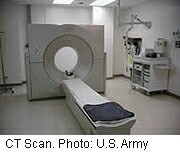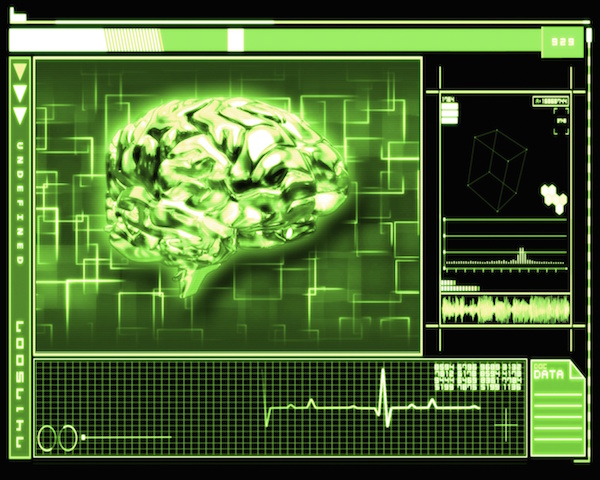
MONDAY, May 9 (HealthDay News) — Children rushed to emergency rooms with minor head trauma often get unneeded CT scans that expose them to high levels of radiation, a new study indicates.
Researchers analyzed the outcomes of more than 40,000 children treated for minor blunt head trauma at 25 U.S. emergency departments between June 2004 and September 2006. They found that four to six hours of clinical observation significantly reduced the use of cranial CT, a neuro-imaging test for traumatic brain injuries, without compromising care.
“There is an increased awareness that a CT scan is not always needed,” said study co-leader Dr. Lise E. Nigrovic, of Children’s Hospital Boston. “An effective strategy is observing the child’s symptoms over time and, if they improve, don’t do a CT.”
Future studies will establish the appropriate length of observation to minimize the risk of missing a serious brain injury, Nigrovic said. The median age of the children in this study, published online May 9 in Pediatrics, was 5.6 years.
Nigrovic said many children show up in ERs with minor head trauma, but very few have significant traumatic brain injuries, identified as a condition resulting in death, brain surgery, use of oxygen tubes for more than 24 hours, or hospital admission for more than two days. She said monitoring symptoms is an effective strategy to reduce CT scans for children considered in the low- to intermediate-risk category.
“We use CT scans for high-risk cases because we don’t want to miss a brain injury,” said Nigrovic. “But if a 3-year-old girl with a headache or vomiting can stay in the ER and be monitored, and if after four hours the symptoms are gone, that’s great. She can go home.”
The ionizing radiation associated with CT scans has been associated with cancer, the authors note. Because their bodies are still developing, children are at greater risk than adults from the long-term dangers.
Rules established by the Pediatric Emergency Care Applied Research Network (PECARN) validate the use of CT scans for high-risk cases, those occurring from certain falls, being struck by an object or getting injured in a vehicle accident when not wearing a safety helmet. PECARN also identifies low-risk cases when a child can be sent home without a CT scan.
“CT scanning is a very powerful tool for ERs, but we have to be wiser as to which patient needs the neuro-imaging,” said Nigrovic, who is also assistant professor of pediatrics at Harvard Medical School in Boston.
In the study, researchers found 5,433 children were observed before a decision on CT use was made, and 3,744 (69 percent) were discharged without a scan. Of these, 26 returned for scans, which detected trauma in four children, but only one significant brain injury.
Of the 34,680 children in a no-observation group, 22,532 (65 percent) were discharged from the ER without a CT, and 81 later returned for a scan. Of these, three had traumatic findings, none significant.
The CT use rate was 31.1 percent in children who were observed, compared to 35 percent for those who were not observed before a decision on CT use was made. Both groups had similar trauma rates, the authors noted.
Dr. Wally Ghurabi, medical director of the emergency department at Santa Monica-UCLA Medical Center and Orthopedic Hospital, said the use of CT scans for children often depends on where the ER is located and the expectations of the parents and local pediatrician.
“This has been a very hot topic for the last two to three years,” said Ghurabi, whose ER has a protocol on CT scans for children. Under the program, a child who is not high-risk receives a physical exam, a non-narcotic painkiller, is made comfortable and is checked regularly by a staff nurse, after which a reevaluation is made.
“There’s no question that a six-hour observation period is an essential part of decision-making,” said Ghurabi. “The only negative thing is ERs are strapped for bed space across the country. So keeping a little kid crying for six hours is an issue. The better part of valor is often to order a CT scan.”
A solution is for ER doctors to discuss the issue with parents, who might mistakenly think a CT scan is needed if a child bumps his head on the carpet, or that the ER is rationing care by not doing a scan, said Ghurabi.
“Parents are a key component in reducing the unnecessary use of expensive CT scans,” he said. “Sit down and explain why you’d rather observe their son than irradiate him with the equivalent of 20 to 30 X-rays.”
The study was funded by the U.S. Health Resources and Services Administration/Maternal and Child Health Bureau, Division of Research, Training, and Education, and the Emergency Medical Services of Children Program.
More information
For more on the care of pediatric head injury, visit the Pediatric Emergency Care Applied Network.

